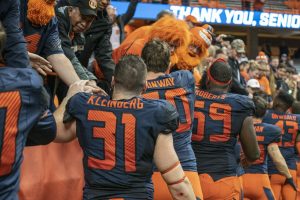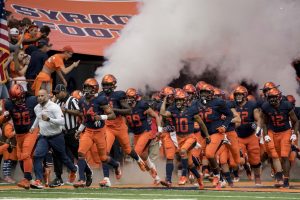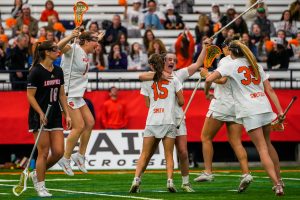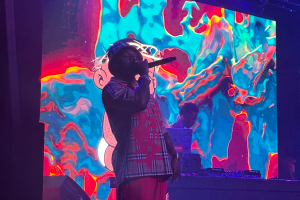What it means to have a black coach: The significance of Dino Babers
What it means to have a black coach: The significance of Dino Babers
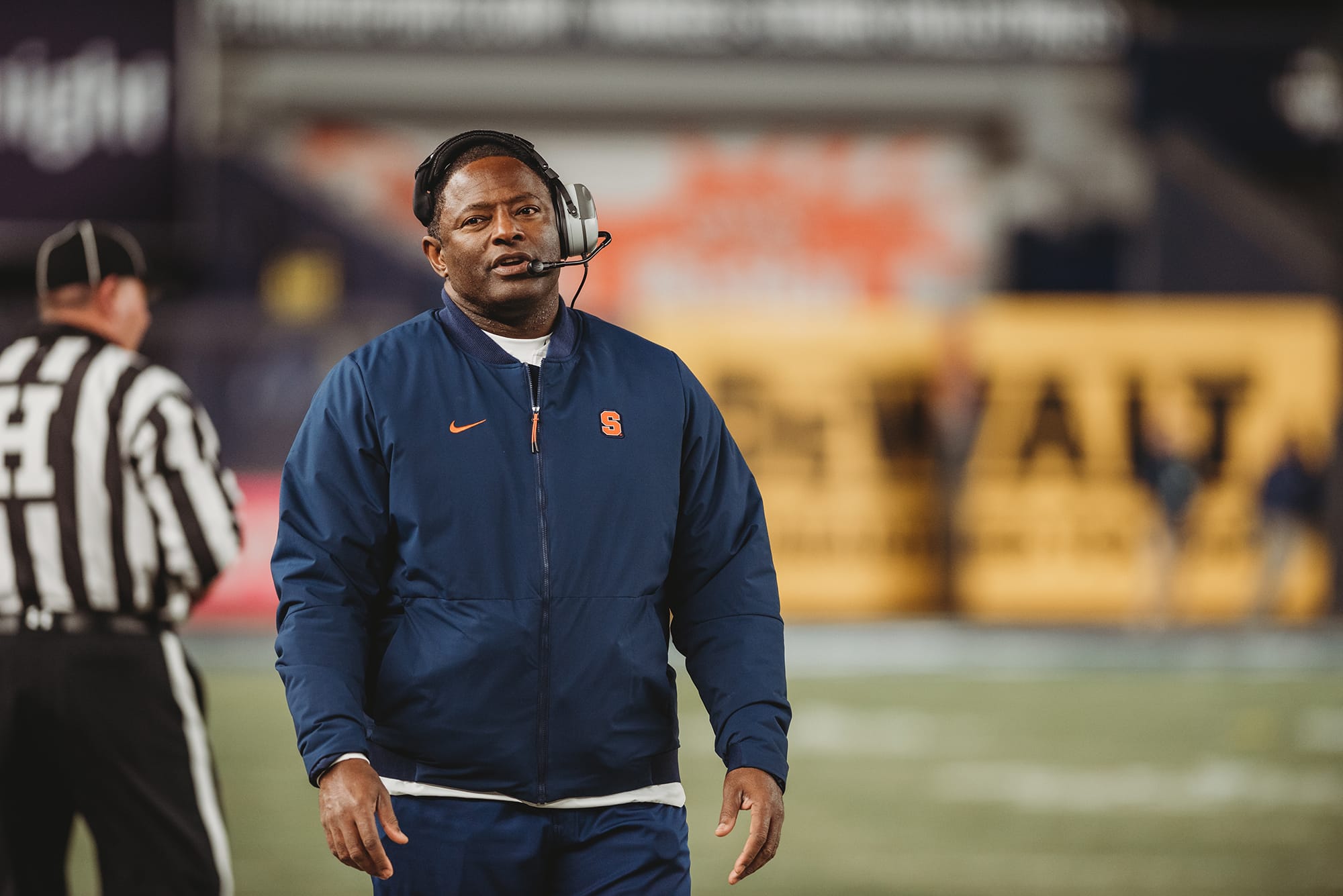
Jamal Custis held a long pause and maintained a blank stare.
When asked about college football’s diversity problem earlier this season, the senior wide receiver couldn’t pinpoint the cause. He hadn’t given the problem much thought. For decades, the subject has been taboo. He didn’t suggest a way in which the issue could be resolved, though he came to one conclusion in his brief assessment of one of college football’s largest issues.
“It is nice,” Custis said, “to see someone who looks like me.”
The face of the Syracuse football program is a black man — a fact that players said matters deeply. Dino Babers, 57, was hired in December 2015 as the first black head coach in the history of Syracuse football, which produced the first African-American Heisman Trophy winner in Ernie Davis.
Because he is a black head coach, Babers is an outlier: Only 12 black head coaches represent the 130 teams in the Football Bowl Subdivision (FBS), the highest level of college football. Nine percent of programs have a black head coach, while 53.3 percent of college football players are black, according to The Institute for Diversity and Ethics in Sport.
In the past month, Babers has led Syracuse to its first bowl game in half a decade and signed a long-term contract extension with the Orange. He led Syracuse to its best season since 2001 and shared the Associated Press ACC Coach of the Year Award with Clemson’s Dabo Swinney. Experts say Babers’ ascension has helped normalize a once unthinkable prospect: a black head coach. They believe that every Babers win represents a small but important step forward for coaches of color.
Babers’ attainment of one of the highest positions in college sports has inspired young people of color to dream bigger. A head coach’s role is large — they spend hours with players nearly every day — and has a type of transformational potential that for decades excluded minorities. In his role, Babers has the power to change how black players on the team think of themselves and the wider group to which they contribute, experts said.
“In a sport where such a high percentage of players are African-American, everybody who has experienced exclusion feels better when there’s inclusion,” said Richard Lapchick, a human rights activist and director of The Institute for Diversity & Ethics in Sport. “To have a head coach who looks like them can be very meaningful.”
Mirror image
The day he was hired, Babers was one of only 10 African-American head coaches at the FBS level. Yet he prefers not to make race a point of emphasis. He’d rather talk about what he does on the field. Through a spokesman, he declined multiple requests to be interviewed for this story. Current and former Syracuse players said he’s never mentioned race in team meetings. He has publicly addressed race once since being hired at SU.
In 2015, he told Sports Illustrated, “I really don’t have thoughts,” about being a black coach. “Woke up this a.m., I looked in the mirror and I was black. I was the first black (football) coach at Bowling Green. I was the first black (football) coach at a private (collegiate) institution in the state of Illinois. Everywhere I’ve been, that tag has come with me. It’s not anything I lay my hat on. I’m about finding a way to help young men if they are willing to grow up to become better fathers, sons and husbands.”
While Babers has largely avoided the topic, there is tangible evidence that he remains a potent symbol for people of color, with a deep reservoir of support. Players and local residents who are black revel in the power of Babers’ example. What they see in someone who resembles them is a role model, and they said he possesses the power to reshape perceptions of what it means to have a leader who is a minority.
Babers also illustrates the fact that having a black coach can unlock new hopes and possibilities in his players.
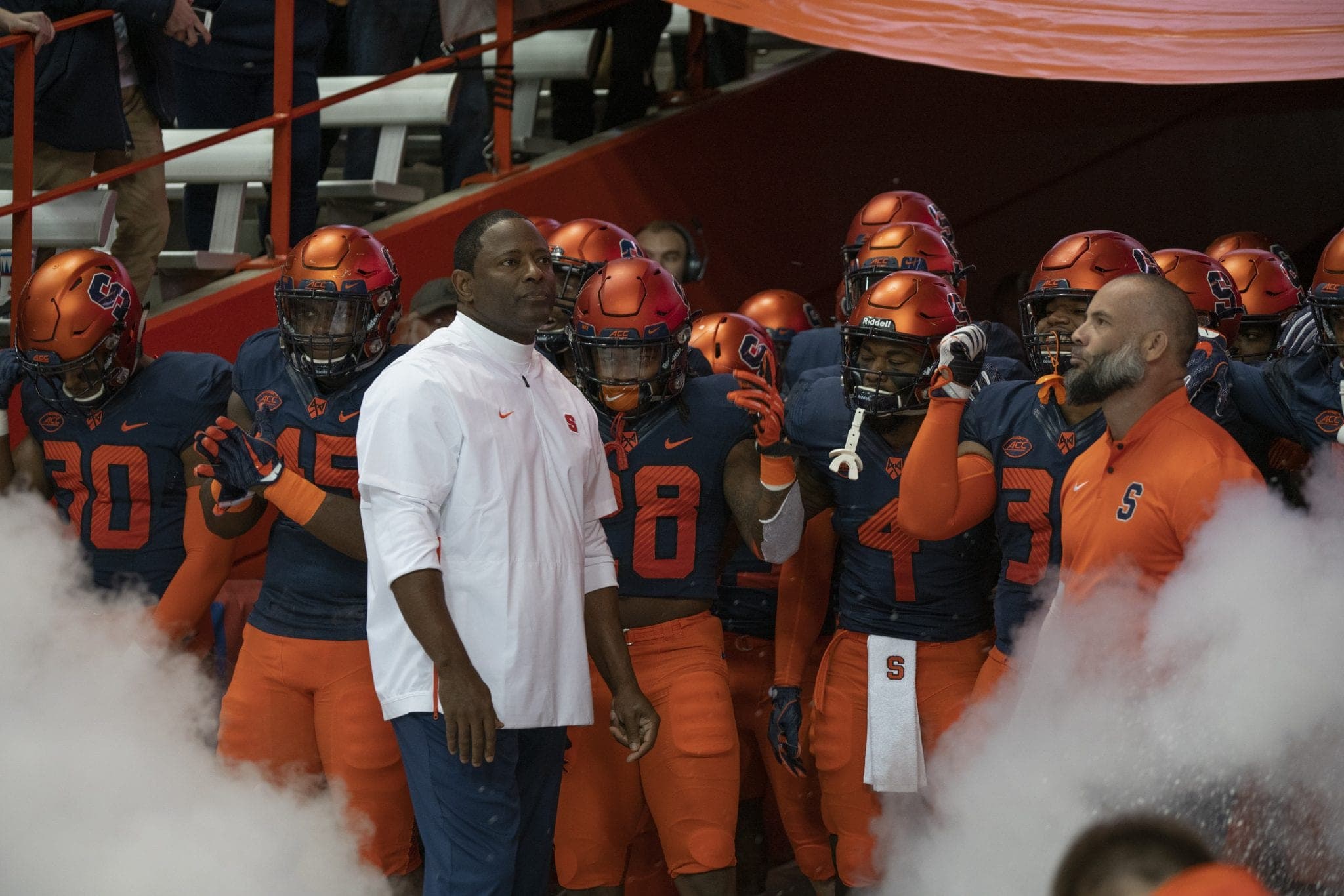
“The connection with some of the players he has, it helps,” said Syracuse sophomore fullback Chris Elmore. “He has some reliability to them. (Defensive tackles coach Vinson) Reynolds is from Detroit, where some guys are from. That connection is there, too. He knows my background like the back of his hand. I’m comfortable opening up to him, because he understands who I am.”
To be a black head coach for a major college football program means more than the face he shows. His importance rests both there and in the heart he shows his players. Which is why in their eyes, he’s a very real thing. Senior linebacker Kielan Whitner said a voice of authority coming from a person of color aligns with what he characterized as a diversity locker room.
Julian Whigham, a former Syracuse cornerback, said that while in training camp with the Pittsburgh Steelers his assignment was Pro Bowl wide receiver Antonio Brown. Whigham kept getting beat, so he jogged over to Steelers head coach Mike Tomlin.
“Yo coach,” Whigham recalled saying, “Can I get a break?”
Whigham didn’t hesitate to approach Tomlin. He said he can’t say for sure that it was because Tomlin is black, but Whigham said that may have contributed to why he didn’t pause to approach him in the manner he did. He was blunt. If his coach were white, Whigham said, he may have thought twice about such an outward approach.
Former Syracuse three-year captain Zaire Franklin, now a linebacker for the Indianapolis Colts, agreed with Whitner and Whigham: There lies power in diversity at the top.
“It’s a blessing to see more people like yourself in situations you dream about,” Franklin said. “To have someone who is African-American like you, coming from a background like you, it gives you a lot of hope. That’s a beautiful thing to have.”
The crux of the issue
Part of college football’s diversity problem stems from the fact that there are simply fewer black coaches in assistant roles in position to be promoted — or even considered for a head-coaching interview. The pool of talented black coaches has been in short supply.
In the early 2000s, Babers served on the Black Coaches Association (BCA) board of directors for about one year, according to Floyd Keith, a former NCAA football coach and former executive director of the now-defunct group. Keith said Babers advocated for placing black coaches in roles where their career trajectory could enable them to eventually become a head coach candidate. In doing so, he pushed for an increase in the number of graduate assistants of color, which would create more opportunities for people of color to rise as head coaches, Keith said.
Keith thought the 2007 Super Bowl between Tony Dungy and Lovie Smith — two black men — would create a spark for black coaches to break through at all levels. It didn’t, and it still hasn’t 11 years later. The sports landscape of TV contracts and instant satisfaction — teams feel pressure to win sooner in a coach’s tensures — sometimes marginalizes their dreams, accentuates their mistakes and keeps them on a shorter leash.
“When you’re the first minority coach at a major university, you feel like there’s so many people counting on you,” now-South Florida head coach and former Texas head coach Charlie Strong told Fox Sports. “I got upset at myself for not being successful, and I got upset at myself because you feel like you let a lot of people down.
“There are only so many African-American coaches.”
Social change such as the diversity of college football leadership takes time, yet coaches are expected to win quickly. Lapchick said many minority head coaches are hired after major programs experienced years of downturn. They start on the bottom and must essentially build up a program out of consecutive losing seasons, which makes success harder.
Plus, Keith said when black coaches are given a chance at the FBS level, they’re thrust under a microscope. “One’s not keeping up with the other,” Keith said. “You’re in the culture now of a microwave. You have to be on your game, and if you win, you’ll be sustained.”
As the pressure has mounted, Keith said there are encouraging breakthroughs. Penn State’s James Franklin, Arizona State’s Herm Edwards, Stanford’s David Shaw, Florida State’s Willie Taggart and Strong, plus Babers, are black head coaches in the Power 5.
“Ten years ago, nobody would have said there’d be a coach of color at those big-time programs,” Keith said. “We never got those jobs.”
Lapchick said the roots of the issue rest at the youth and high school levels. He believes there needs to be more accountability in high school sports: Schools should be required to report the racial makeup of each team, from players to assistants to head coaches. Lapchick also notes that nearly all of college presidents and athletic directors are white men; they have a propensity to draw from their existing peer groups.
Keith and Fritz Polite, an and Shenandoah University’s assistant dean of Student Affairs, implore the NCAA to mirror the NFL. In 2003, the NFL implemented the Rooney Rule, requiring owners to interview minority candidates. They both said the rule could be taken a step further at the college level: Athletic directors could be required to interview minority head coach candidates, and head coaches could be required to interview minority assistants.
And yet research suggests the rule does not equate an inclusive environment. From 1985 to 2012, professors at Georgetown, George Washington, Emory and Iowa State University tracked the careers of more than 1,200 NFL coaches white position coaches and assistants in the NFL are more than twice as likely to be promoted to coordinator than their black counterparts. That’s regardless of their performance, experience or coaching background.
The representation on the field is not the same as the one on the sideline. Keith, Fritz and Lapchick point to one thing: discrimination.
In Babers, a role model
When Babers was hired on Dec. 5, 2015, a group of local high school coaches texted one another. Nottingham High School head football coach Fred Wheeler said he was pleasantly surprised when he found out Babers was hired. “Well, this is cool,” he remembers telling a few friends.
Wheeler said he sees every Babers win as opening the door for other black coaches, himself included, to break into the industry or rise up a level. Wheeler credits his coaching successes to the fact that he grew up with minority head coaches himself.
“That gave me something to shoot for,” he said.
Nottingham High School Athletic Director Alton Hicks was previously the school’s principal. He said a student once judged him for the color of his skin and said, “What are you, the custodian?” The discrimination, he said, resulted because they weren’t accustomed to a black person in a leadership position at the school. He also said he’s seen students respond to white teachers and coaches before they respond to him.
“They’re used to white males being in control,” Hicks said.
For Nottingham players of color, it was such a relief to see someone to whom they felt they could relate better. Then-Nottingham high school sophomore Skakim Muhafiz said he was “pleasantly surprised” in December 2015 when SU hired a minority head coach. He felt proud himself.
Muhafiz said Babers gave him a new reason to watch Syracuse football. He attended a Syracuse football camp to see Babers, and he sees the coach’s success as a foundation for minority children in Syracuse who may consider leadership positions after school.
Say I want to be a head coach?” Muhafiz said. “Kids will see his rise and they’ll want to be it. If they see the majority is white and they don’t have that confidence, they won’t go for it. But if we see it’s starting to come into place, we’ll have that confidence to take that leap.”

